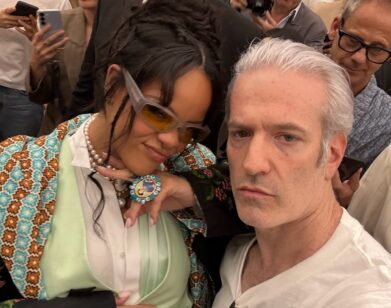Discovery: Assaf Reeb
There’s something magnetically elusive about Tel Aviv-born Assaf Reeb’s menswear. It’s ambiguously European in flair, it’s anti-profligate in construct, and it’s retro-summery in vibe, summoning images of grand old men of the Riviera hopping around the Mediterranean’s rocky shoals. Reeb is a de facto minimalist, yet one who appreciates that minimalism needn’t always be slicked-back and shellacked. He examines a quieter version of riot, seeking purity through the conceptual, via acute research and stripped-to-the-bone thoroughness—a trademark no doubt instilled by his alma mater, Central Saint Martins.
Just this past London Fashion Week, Reeb matriculated from the school’s intensive (and now very famous, thanks to Christopher Kane, Phoebe Philo, Stella McCartney, et al.) Master’s fashion program. He made the show, too (traditionally, program director Louise Wilson selects approximately half of the graduating class to display their collections on the Somerset House runway). Presenting is a big honor—and an even bigger pressure. Now in the wake of finishing his studies, Reeb discusses his development as a designer, his future (it may involve kites), and the negative space of nudity.
HOMETOWN: Tel Aviv, Israel
CURRENT LOCATION: London, United Kingdom
CENTRAL SAINT MARTINS, FOREVER AND ALWAYS: I’m from Tel Aviv—it’s a really great city, but fashion is not one of its strengths. So even if it sounds clichéd, coming to Saint Martins to do the Master’s program was a dream. Louise Wilson is the most intelligent and committed teacher I have ever had, and being able to work directly with someone at her level on a daily basis—it was a privilege. I had the designer Peter Jensen as my menswear tutor, and he too was wonderful. The whole course felt a bit like being put in front of a mirror, but a mirror reflecting only your weakest points. Hopefully, that alone makes you a better designer at the end of it. Besides working on menswear, I was also given a chance to take part in a collaborative collection with Pringle of Scotland. They actually produced some of my pieces, which was amazing. On the whole, I feel that it was an empowering experience.
FW13 JUMP-OFFS: I found some really beautiful images from the early 20th century showing young boys practicing sport—rowing teams, football players, swimmers. There was a naïveté to their outfits, but at the same time, they were so daring—though not in a vulgar way. It was a challenge to translate those outfits into something men would consider wearing today. Another concept was taking very classic shapes, slicing them apart, and trying to come up with new ideas for visual balance.
SKIN IS IN: Nudity is so important in fashion design! And in menswear, it’s almost completely ignored, which I think is a shame. Skin is exciting, it is a powerful tool we usually take for granted in the design process. If you were doing typography, you’d give just as much thought to the spaces between the letters, so why not do the same with clothing?
BEING A MAN: While it can be read as beachwear, I think the way I design is quite versatile, in terms of being wearable. It’s all about simplicity and casual, generic shapes that I try to make more elegant—a t-shirt done in suiting fabrics, or a frayed towel lined with lightweight wool. I think menswear is currently having a great moment, because men are evolving stylistically and womenswear is so saturated, and we are starting to more freely investigate what “being a man” means, today.
DIGITAL DREAMS: I think any good design team needs to have someone who really understands technology, and I would love to collaborate on a project with someone like, say, a software engineer. I think most of this sort of work and context in fashion focuses on sales platforms and new ways of marketing, but there are so many untapped opportunities on the creative side, and for me, that could be something very exciting to work on.
KITE RUNNER: For my next project, I don’t want to say too much, as I’m still in the early stages of the idea, but I am really interested in designing kites. Essentially, kites are objects of paper and fabric that are meant to fly around with no function other than to look and be beautiful, which I think is a very romantic concept. I am working on developing that into something that comes from a more fashionable perspective.







